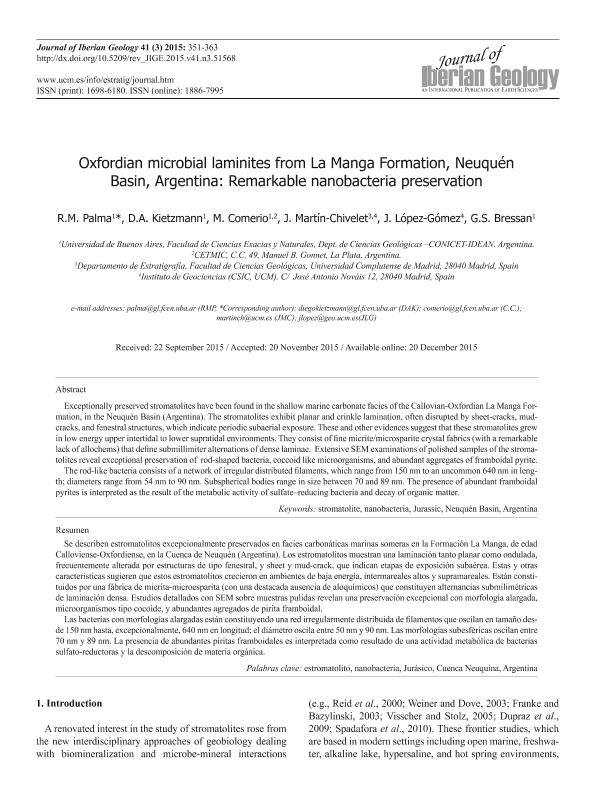Artículo
Oxfordian microbial laminites from La Manga Formation, Neuquén Basin, Argentina: Remarkable nanobacteria preservation
Palma, Ricardo Manuel ; Kietzmann, Diego Alejandro
; Kietzmann, Diego Alejandro ; Comerio, Marcos
; Comerio, Marcos ; Martín Chivelet, J.; López Gómez, J.; Bressan, Graciela Susana
; Martín Chivelet, J.; López Gómez, J.; Bressan, Graciela Susana
 ; Kietzmann, Diego Alejandro
; Kietzmann, Diego Alejandro ; Comerio, Marcos
; Comerio, Marcos ; Martín Chivelet, J.; López Gómez, J.; Bressan, Graciela Susana
; Martín Chivelet, J.; López Gómez, J.; Bressan, Graciela Susana
Fecha de publicación:
12/2015
Editorial:
Servicio Publicaciones
Revista:
Journal of Iberian Geology
ISSN:
1698-6180
e-ISSN:
1886-7995
Idioma:
Inglés
Tipo de recurso:
Artículo publicado
Clasificación temática:
Resumen
Exceptionally preserved stromatolites have been found in the shallow marine carbonate facies of the Callovian-Oxfordian La Manga Formation,in the Neuquén Basin (Argentina). The stromatolites exhibit planar and crinkle lamination, often disrupted by sheet-cracks, mudcracks, and fenestral structures, which indicate periodic subaerial exposure. These and other evidences suggest that these stromatolites grew in low energy upper intertidal to lower supratidal environments. They consist of fine micrite/microsparite crystal fabrics (with a remarkable lack of allochems) that define submillimiter alternations of dense laminae. Extensive SEM examinations of polished samples of the stromatolites reveal exceptional preservation of rod-shaped bacteria, coccoid like microorganisms, and abundant aggregates of framboidal pyrite.The rod-like bacteria consists of a network of irregular distributed filaments, which range from 150 nm to an uncommon 640 nm in length; diameters range from 54 nm to 90 nm. Subspherical bodies range in size between 70 and 89 nm. The presence of abundant framboidal pyrites is interpreted as the result of the metabolic activity of sulfate?reducing bacteria and decay of organic matter.
Palabras clave:
Stromatolite
,
Nanobacteria
,
Jurassic
,
Neuquén Basin
,
Argentina
Archivos asociados
Licencia
Identificadores
Colecciones
Articulos(IDEAN)
Articulos de INSTITUTO DE ESTUDIOS ANDINOS "DON PABLO GROEBER"
Articulos de INSTITUTO DE ESTUDIOS ANDINOS "DON PABLO GROEBER"
Citación
Palma, Ricardo Manuel; Kietzmann, Diego Alejandro; Comerio, Marcos; Martín Chivelet, J.; López Gómez, J.; et al.; Oxfordian microbial laminites from La Manga Formation, Neuquén Basin, Argentina: Remarkable nanobacteria preservation; Servicio Publicaciones; Journal of Iberian Geology; 41; 3; 12-2015; 351-363
Compartir



